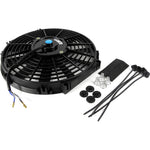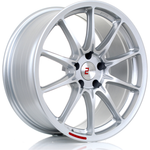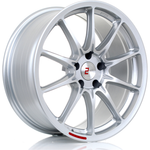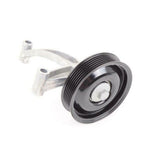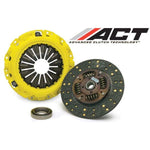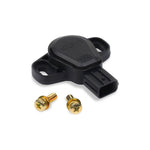You have no items in your shopping cart.
FROM ROAD CAR TO GOLF MK7 GTI RACE CAR
Our Golf MK7 GTI Race Cars are now Championship winning race cars but we’ve never really shown anyone how this all came about, how we got involved with them and the process we went through to make them both fast and competitive.
We’ve been known for a number of years as the go to place for your Honda Civic Type R Track and Race Cars having won over 10 Championships with our cars. Whilst we still are heavily involved in Hondas we wanted something else to develop for our customers.
Rewind to 2019 we purchased our first Golf MK7 GTI, the car in spec was a performance Pack DSG 2014 GTI, it had a few modifications but was mainly in totally stock form. We saw the car as a great platform to build upon for circuit use although of all the track and test days we do we’d never really seen many out on circuit, which really got us wondering why? Was it due to cost or was it just that the platform wasn’t a trusted capable track car.
Our first goal was to see what we could do to turn it into a Track car that was still perfectly capable and comfortable of being used for day to day use.



First Modifications Golf MK7 GTI Track Car
The basics were obvious in that we needed to get rid of the factory 19” wheels and replace with 18” and some Michelin PS4 Tyres. We started off with a 18×8 ET42 Team Dynamic Wheel that we picked up used. Next thing on our mind was suspension and cooling. We couldn’t really find any information on people using this cars on track with what cooling was required, what temps people were seeing and what were the important upgrades required to allow a trouble free track day. We decided to do what we thought would be best (It wasn’t) in fitting a Airtec intercooler to keep the Intake Air Temps under control, along with a RacingLIne Oil Cooler Kit and a larger 13 Row DSG Oil Cooler which is a stock replacement part from another MQB Car. In our eyes these products seemed to be the go to aftermarket products for track use and keeping the Coolant, Oil, Gearbox and Oil temperatures under control.



The car already had a APR Downpipe, Cat Back and “Stage 2” map with a dyno printout of a optimistic 347HP so we weren’t overly concerned about mapping and power at this stage. More just doing the basics and getting out on track and testing it. We did however add a Racingline Catch Can kit which is essential really for track use due to Oil surge through stock PCV which gives a large cloud of smoke under braking / cornering out the back of the car and will likely see you black flagged on circuit and sent home, not what you want!
Suspension we went to YSR Suspension (YellowSpeed) a brand that many will not know of in the VAG Tuning Circle but a brand we know extremely well from our Hondas. We’ve ran these shocks on our race cars and track cars for years with 0 issues so that’s what we decided to go for to start with. With our experience of VAG TCR Cars we knew the YSR Spring rates weren’t quite suited for track so we changed them out for what we knew worked on the MQB platform from our TCR Experience and got them fitted to the car along with some Hardrace Adjustable Drop Links. We then changed the stock rear Camber and toe arms to Hardrace to allow us full adjustment in rear Geometry and fitted a Hardrace Rear 25.4mm anti roll bar with adjustable Whiteline drop links.




The only other change we made was to a YSR 356MM Disc 6 Pot Brake kit with some RS29 pads. One bit of information we could find on the internet was that the stock brakes were simply not upto the task of track use all day long but were ok for 8 minute laps of the Nurburgring for example with cooldowns inbetween providing a uprated pad, lines and fluids were fitted. We would be pushing this car extremely hard so decided to change the stock brakes out straight away to ensure we didn’t end up frustrated on our first day out in the car after a few laps with inadequate brakes. We also picked up from our friends at RotaUK some 18×8.5 ET42 Rota Strikes and fitted them with Dunlop Direzza’s in 235/40/18. We wanted to ensure the car handled well on both Michelins and Semi Slicks so on our first day out we would run both tyres.



First Track Day – Blyton Park
We headed up to Blyton Park for the first day out in the car. Although a small circuit it is actually very good for testing as you’ll see from the video below. The circuit has both fast and very slow corners which will test the platform well. The day was dry which was perfect for what we wanted to achieve, we ran a AIM SOLO 2 in the car which gave us basic datalogging of all Temperatures, boost and also data that we could overlay where required.
First Two Sessions Out
We took the car out on the first session on the Michelin Tyres, you could immediately feel how good and capable the chassis would be even from the opening 20 minutes on Road Tyres. We did notice straight away the Temperatures started to creep up without stabilising at any point on the Coolant Temp in particular, even though the stock Dashboard was sat at 90 Degrees C the Temps on our data climbed to over 110 Degrees C after a 20 minute run. Temperature did decrease quickly however on a cooldown lap dropping over 15 Degrees down to 95 in the one lap into the pits. Aside from the Temp issues we were extremely impressed for the most part with the car. Traction was fantastic although you could certainly feel some electronic intervention that we needed to get rid of even with the traction fully off and the normal VCDS recommended modifications.
We opened up VCDS to make some changes as from feel alone it felt like the brake was being applied on corners to aid traction, a system called XDS on the MQB Platform. Although the system in description should aid cornering it was hindering the car in pace and driver feel so we disabled it for the next session and aside from that kept everything the same. Immediately on the first flying lap you could tell the problem was sorted and we went over a second quicker on lap 2 straight away just from this change within the software.
With the car really feeling well balanced in this second session we tried a range of damper click changes and monitored the tyre temperatures to ensure our setup on the car was suitable. As expected the front inside edges were around 20 degree hotter than the outside which was to be expected on a road tyre with geometry more targeted towards track use.
Alignment settings we were running on the day was -3 Front Camber (The maximum available on the YSR Damper Top Mounts), -2.5 Rear Camber with 0 Front Toe per side and 0 Rear Toe.



Fourth and Fifth Sessions
For the remaining sessions we switched over to our wheels mounted with Dunlop Direzzas. As you can imagine even against what is regarded as the best road tyre the grip offered and corner speed was increased massively. The car still remained very neutral which was good to see as we wanted to be able to provide customers with a platform that wasn’t just tyre dependent and would work on tyres of varying grip levels well. Through these sessions we would check the temperature spreads once upto pressure and saw a 5 to 10 degree spread across the tyre which is always the target.
For the remaining time we’d try different rear toe settings which changed the balance as expected with toe out on the rear aiding low speed turn in but decreasing high speed stability.
Lap time wise we were quite close to what we’ve done round there in one of our Civic Cup Cars which was unexpected but impressive all the same. The car does have a extra 45HP per tonne over a Cup Car but even so, this was a mild road car in comparison to a fully fledged race car.
Conclusion
From the day we were very impressed with what had been achieved with minimal modifications, there was work in areas to be done for sure but in general the car did the full day with 0 issues aside from the high temps which we would address.
You can view some laps from the day above here
What was next?
We didn’t change much on the car aside from adding a SW Motorsport Half Cage and some Atech racing bucket seats, the grip the car offered it became increasingly difficult to hold your self in the seat so this was a welcome change. From here forward we took the car to Donington Park and to the Nurburgring. Donington park was another day of trying different things and more importantly ensuring we were able to offer our customers a package that worked on both road and track. We addressed the temperature issues by removing the Airtec Intercooler and refitting a Stock Golf R Intercooler. With this done Coolant Temps were much more under control due to the airflow through the Intercooler to the water radiator. Even though intake temps rose they were well within parameters even on a 24 Degree C Ambient day.



Don’t make the same mistake we did by fitting a large intercooler where it’s not required. We have now found the perfect intercooler from HPA Motorsport which allows adequate airflow through to the water radiator and decreases intake temps by 10-15 degrees over the Golf R Intercooler. We mainly did this as it was required now one of our cars is running 380 HP. If you are running anything 340-350 HP and below, we highly recommend keeping the stock intercooler for track use and spending your money in other areas.
Nurburgring cemented that we had created a great package that was budget friendly and expandable for customers in that the car handled the notorious bumps and undulations on the Nubrurgring extremely well and completed the round trip including a number of laps with no issues at all and in full comfort on the road.|
There will be another post going much more in depth with another Golf MK7 GTI on modifications for track use in the future!



We were getting more excited by this platform and the thought then became of turning it into a race car for endurance racing.
Turning the car into a Race Car.
Obviously in principle this is easy, you strip the car have your cage and safety equipment fitted and go racing. But our competitive nature saw us not want to just create a car that was capable of racing and passing regulations, we wanted it to be fast, reliable and capable of winning championships.
Roll Cage and Paint Golf MK7 GTI Race Car
First things first the car was stripped bare of it’s interior and whilst doing so we planned out where we wanted to mount components based on weight balance and how we wanted the overall layout of the car to be. We then had Shaun from SW Motorsport come down to us and scan one of our VAG TCR cars to use the basic dimensions and pickup points for the cage. When planning your race car this is the time to ensure everything is correct and SW Motorsport do a great job of listening to our plans and ideas and implementing them. With the car being built for endurance use we had air jack mounts integrated into the cage for quick pit stops, Fuel tank mounts across the rear bench which would increase fuel capacity to 108 LTRS using a Pro Alloy 54 LTR tank. We then had Airjack Lance and Fuel Dump fittings welded into the window housing along with some bosses welded into the floor for mounting the extinguisher and radio and finally seat mounts and a footplate made by SW.



We got the car back and before paint set about prepping the wheel arches and floor pan removing any unwanted underseal. We also really wanted to fit 10” wheels all round on the car with a 265 tyre so we first attempted flaring the rear arches which wouldn’t work, more on getting these to fit later!


With the shell prepped for paint we chose to have it done in the same white as the exterior and a few weeks later the shell came to back to us looking brand new ready to build up.



BUILD UP GOLF MK7 GTI RACE CAR
Over the weeks the car had been at Cage and Paint we’d planned out all the components we wanted to use and how we wanted everything to work which would hopefully create a car that was capable of doing the 2 and 3 hour races it would compete in. Totally different to the 20 minute sessions we had been doing with the Track Car.
With the car back we started on the interior first, With a blank Shell you always want to work methodically so you don’t end having to remove parts to refit other components. We would first mount the AirJacks from YellowSpeed and run the hardlines for them. We’ve used the YellowSpeed Airjacks in multiple cars and have never had any issues with them, we also have cars in comparison with AP Airjacks which regularly need servicing! Once these bits were in place we set about mounting the battery, extinguisher and running the extinguisher lines.



With the components in place required we would then set about refitting the wiring along with the wiring for our steering wheel controls and other additional components. A tip from us especially on cars like this is to not over complicate things. The car needs to be easy to work on, easy to find issues when problems arise and to not create problems further down the line. We firstly run all the wiring for our controls, radio kit and any spare inputs are put onto plugs for later use making them easy to access if customers want to add a drink system or any other electronic devices. We’d then prewire the various dash inputs ready.
Once all the above is done we’d refit the stock fuse box in it’s stock location and run the wiring to the various places its required around the dash bar and car. With the car being keyless we’d use the stock start button for our Ignition Switch and a Cartek Isolator to Isolate the electronic components as per FIA and MSA Regulations. Once a system check was done to ensure there were no abnormal faults we fired the car up to make sure everything was working as it should be.
We used a ECU Master Dashboard and wizardry from Kevin Glover got us all the CAN Information into the dashboard we could ever want. This allowed us to program alarms, set a pitstop timer and log all aspects of information on the car.



One thing that required some thought was how to have a aftermarket steering wheel with DSG Paddles and the steering wheel controls all work as one. KMP Do a kit for this that is over 2400 pounds and wasn’t a solution we wanted to use. It wasn’t a case of simply adding aftermarket paddles and splicing wires as they work through CanBus. What we managed to do in the end was separate the paddle switch boards and house the boards inside the boss it’s self. This ment that the paddles worked as standard, we could use our wireless button switch panel and the indicators and all wipers etc would still work correctly.
The final pieces to the puzzle was making everything look nice and secure. The team set about using carbon sheet for the switch panel and blanking of any unwanted holes, making the door cards and then moved onto the Fuel Tank.



The way we had planned the fuel tank to work was again with the mindset of making everything as reliable and simple as possible. These cars can be very sensitive on fuel pressure and fuel pump changes so we decided to effectively use our Pro Alloy Fuel Tank as a feeder tank to the stock one. The way we did this was by mounting the tank in the centre of the car for the best weight distribution and meaning it could simply gravity feed the stock tank. By doing this there is no extra switch the driver needs to mindful of to transfer fuel. Our tank was specced to have a AN8 Feed at the bottom with a internal collector (trap doors that allow fuel in but not out so there is a constant fuel supply). We then drilled into the top plate of the standard pump a AN8 Fitting which would be used for the feed along with a push fitting with a AN6 feed to breath back to the Pro Alloy tank. For fuel filling we used a Premier Dump Churn Nozzle whilst the stock fuel filler can also be used. Finally we added a AIM Fuel level probe to the Aux tank which allowed us to display on the dashboard the stock tank fuel level and the aux tank fuel level along with a fuel total.
The tank then required a bulk head to separate it from the driver which was formed by SW Motorsport for us and mounted over the top of the Pro Alloy Tank.



Suspension and Brakes GOLF MK7 GTI
Now the interior was complete and the car running we set about changes to suspension and braking. Whilst our track setup was brilliant we needed Larger Brake Pads in terms of thickness and suspension that was solely focused for Motorsport.
Brakes
For the Brakes it was relatively simple to sort, we used the same AP Racing Caliper that we use on our TCR Cars along with the same brake bell and disc setup. We knew this setup worked as it works on the TCR Cars so it was a no brainer for us to go down this route. The only parts we had to change and have made were the brake caliper brackets as we were retaining the stock suspension uprights and the TCR cars use custom billet ones we needed brackets to suit. We had these produced by BAKER BM and everything fitted to the car perfectly. For now for the rear calipers we just used the stock disc and caliper setup with some different brake pads.
In terms of the brake system itself we had found the stock ABS to be extremely good when the car was a track car so we retained the stock hardlines, pedals and ABS system and just added braided lines where needed. Another point to note on these cars is that a whole host of information runs through the ABS Pump. Removal of the pump would mean no traction would work which we really wanted to retain for drivers to use in wet and greasy conditions. There is also the option within VCDS to change the front to rear balance if required meaning we could effectively adjust the bias although not from the cockpit.



Suspension Golf MK7 GTI Race Car
We made a large amount of changes to the suspension with the car now becoming a race car. There were some simple choices such as changed the Poly Rear Toe and Camber arms to Hardrace Spherical versions. We retained the stock front roll bar along with the Hardrace 25mm rear bar and also retained the adjustable drop links we already had fitted.
The other parts came from Verkline in the form of tubular adjustable front wishbones, these not only give you infinite adjustment but they also correct the roll centre changes that are seen from lowering the car. On the rear we used the Verkline Spherical Trailing Arms which have some adjustability to change the pitch of the car under braking and acceleration although through all the testing we left these on 0 / 0 settings. We changed the inner and outer hub bushes to spherical joints and added some ClubSport Front Hubs which give around 1 degree of camber increase. The hubs were added mainly because we were so tight on wheel clearance, not because we couldn’t achieve the required camber through the adjustment we had.
The final piece of the puzzle was the Coilovers. We have worked with Nitron for years and at the time they didn’t have a Coilover Kit for the MQB Platform. We worked with them closely on specs for valving and spring rates and they produced exactly what we needed. The top mounts upfront allowed for upto -4.5 camber even when on a stock wishbone. The quality was brilliant as to be expected and we could only hope they performed as well as they looked.
With the suspension all complete and obviously we recoated and finished all other components before build up we added a RacingLine Rear engine mount along with Direnza Gearbox and Drivers side mount.









You can view a full walk around of the suspension here
Its Nearly Ready….
There were some other finishing touches we needed to do before the car hit the circuit. For the time being we were going to run the car on 10” Front wheels with a 265 tyre and 9” Rear wheels with a 235 tyre. In order for the front wheels to fit we needed wider wings which we purchased from SRS-TEC in Germany. These were high quality and required 0 fettling to fit and also had a built in arch liner Most importantly they allowed us to fit the wheels and tyres we wanted.



One of the big changes we made was to change the DSG Gearbox to a Golf R DSG Box. The Golf GTI for some reason has extremely long gear ratios in DSG form (4th gear will do over 130MPH!). Golf R, Clubsport, Cupra 280 290 all have much more favourable ratios especially for circuit use. We picked up a GOLF R Gearbox and installed into it a Drexler LSD, we then fitted it to the car and had it coded. You can’t unfortunately just fit the box on its own as component protection will stop it working.
Other small modifications were the addition of a Direnza aluminium radiator. We used this radiator because it costs under £300 and we have already used the CSF variant that’s over £700 and there was no difference between the two whatso ever in coolant temps. We also changed the Oil Cooler from the stock RacingLine 10 Row cooler to a Mocal 16 Row whilst retaining the rest of the RacingLine Oil Cooler kit just to aid cooling further with the 2 and 3 hour races we would do.
Finally we had the car mapped with the freshly installed HPA OEM+ Turbo to 307 HP which would see the car at 240 HP per tonne without driver. We know the car can do more and it now does on power but this car is for racing and has to meet regulations, there was no point us testing its pace and performance if the car didn’t meet the championship requirements.
First Test Day – Donington Park Golf MK7 GTI Race Car
So that was it, after all the hard work, the car was ready to hit the track. We headed to Donington Park to put it through its paces. The car from the outside still looked relatively road spec but the underneath certainly wasn’t. We hit the circuit for the first session and did some installation laps as we always do with a freshly built car. After a couple of checkovers it was time to push it harder and see what it was capable of.
Immediately Rob driving was blown away by the sheer grip offered from the platform. Having raced and won championships in Civics and TCR Cars over previous years he couldn’t believe how good the car was at mid to low speed corners in comparison to even the TCR car. Throughout the day the team made a number of changes fine tuning the suspension, checking all temperatures and pressures that were logged and ensuring everything was running as it should do.
We went to the day with the mindset that if we could get into the 1:16s then the car considering it was it’s first day out would be in a very competitive shape for the Club Enduro Championship. After nearly 200 LTRS of fuel throughout the day Rob went out for his final run with the car effectively set for qualifying. Low fuel and new front tyres saw him achieve a 1:16,6 in the car, a time we were really happy with knowing we had more to come.
Day done we couldn’t of been happier with how the car performed and what we’d achieved but we wouldn’t be stopping here, there were more ideas and plans.



CHANGES AFTER DAY 1 Golf MK7 GTI Race Car
After day 1 out in the Golf MK7 GTI Race Car there was some finishing up to do on it, simple things like the addition of proper tow straps and some finishing up in the engine bay. Our main focus now after a successful first time out was the addition of some aero along with how we were going to fit the 10” rear wheels.
For the aero we set about developing our own chassis mounted Splitter kit for the Golf MK7 GTI Race Car . The kit itself attaches to the crash bar entirely and is rock solid using 12mm Buffalo board. We used the airdam kit from UpAClick the same one we use on our Civic Cup Cars. We then utilisted the Aluminium sump protection tray for extra forward impact rigidity and that was it completed. Only other aero component we added was a TCR Bonnet Scoop to help evacuate the air out the back of the radiator.






Getting the rear wheels to fit would involve cutting into our lovely GOlf MK7 GTI Race Car rear quarters and there was no way getting around that. The guys in the workshop set about modifying the rear arches for clearance and ensuring the clearance would be sufficient and everything was sealed correctly. Then on the way home Rob spotted a R53 Mini and thought those rear arches might work. Some were purchased along with a set of side skirts and our rear arch kit all fell into place. I know many will be thinking really, a Mini, but why over complicate things, if it fits and works and is readily available then use it!
With all the clearance now done we could fit our 10” wide rear wheels with 265 tyres easily. We reprepped the car and it was ready to head back to Donington to see if our changes had any positive impact on performance.






DONINGTON TEST DAY 2 Golf MK7 GTI Race Car
We entered into the second test day with now a lot of knowledge from day 1 and could hit the ground running straight away. We already had the cars alignment settings well tuned and aside from any changes the aero and wider rear tyres would make we would spend the day with the aim of putting more mileage on the car.
The day was very busy with minimal clear laps which wasn’t a issue for putting mileage on, Rob did report that the aero had for sure made a difference with the car in general feeling even better than it did the first day. With over 70 laps completed up until around 3PM the guys had a general check over the car and the day was quietening down out on circuit.
Rob went out for the final run on tyres that had done over 50 laps and managed to get a few clear laps in. After the final run we were amazed by the performance and the difference the small changes had made. The car manged to do a 1:15,9 something we didn’t think would ever be possible at this power to weight ratio and this was on used tyres! To put this into perspective the time our TCR car does with the same driver and tyre is a 1:13,9 in qually trim on the same tyres. That’s a factory built TCR car for comparison with 60hp Per tonne more and a whole lot of aero. We managed to overly the Golf against the TCR and could see that 1.6 Seconds of that time was in a straight line, the other 3 tenths was down crainer curves due to the lack of rear aero. In 2 days and after a lot of planning we’d achieved what we wanted to and more than we’d imagined would be possible.






You Can view the 1:15 lap Below
Heading into the Race Season.
We wont go through to much of the race season purely because this post is more about how we’ve turned the road car into a race car. All the above on the car mentioned happened between May of 2021 and October of 2021. Over the winter we would build more Golfs for customers and would enter the 2022 Club Enduro Championship with 4 identical cars. The championship would see over 20 cars compete in class B where the Golfs would run, the cars varied from Caymans, M3s other MQB Cars, Civics and class B Club Enduro would be the most competitive class throughout the season. Luke Handley took the championship in his Golf MK7 GTI Race Car never being off the podium all season long with 2 Wins along the way. Chris Freeman would complete some rounds of the season and took wins and fastest laps. Jonathan Packer for all but a bit of a bad luck with contact from a competitor was in the title fight till the end. Chris Plaskett completed the first half of the season in his GTI brand new to racing scoring a number of top 5 finishes.
Our new Area Motorsport Golf Mk7 GTI Race Cars took 17 Podiums along with 5 out of 7 available wins and the cars completed over 30 hours of track time each throughout the season including test days with 0 reliability issues.
We hope that you’ve enjoyed reading this as it’s took some time to write down. We still have a lot more to share on how we are now taking these cars from Class B cars to Class A for the 2023 season to compete directly against other TCR cars, M3s and highly strung lotuses.
A massive thank you to all our Team, Sponsors and Partners involved
YGHP – Yates Group Heating Products
HPA Motorsport – HPA Motorsport
Tegiwa Imports – Tegiwa Imports
Nitron
Questmead
EFI TUNE (Kevin Glover)
Maxd,IT Andrew



